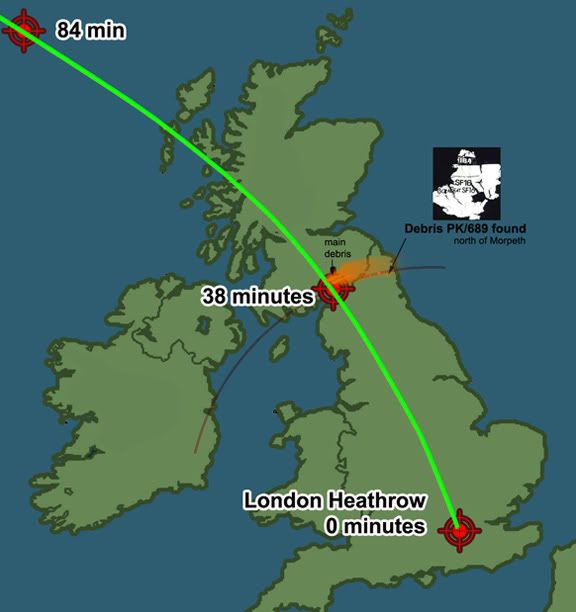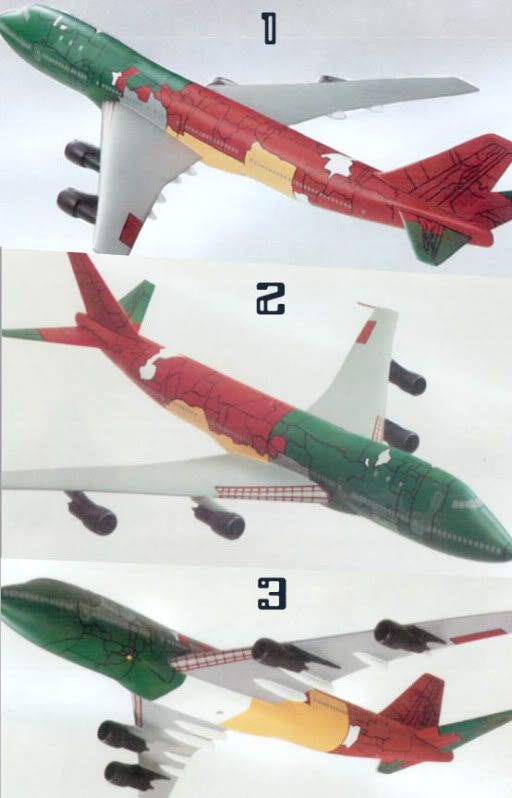lat edits Jan 3 2011
Note throughout: This post, text and graphics, are imprecise and not fleshed out with detailed research. The concepts are general enough, however, that this is acceptable. Do see beneath comments from Rolfe, who has looked at this better and offers more in a few long submissions.
---
"But Flight 103 was Behind Schedule" is one of the most persistent myths of the Lockerbie bombing. It's the standard answer when anyone asks why the Libyans set their timer so early. For example, the BBC Conspiracy Files episode on the bombing (2008) starts out:
In the end, it came down, as most things do, to a simple twist of fate. 600 seconds. That's all that was in it. Had the bomb which destroyed the Pan Am exploded just ten minutes later, the plane would have been over open water, and all the evidence most likely lost at the bottom of the sea. But as it was, the bomb blew up over land, and the small town of Lockerbie became a by-word for the worst act of terrorism ever to take place in Britain.A montage of the effects is shown, and the next words, curiously, are: "the investigation turned on one tiny piece of evidence ... this fragment [shown, of an MST-13 timer] was the breakthrough that cracked the case." The time of explosion over land - 7:03 pm, just 38 minutes after takeoff - wasn't caused by "a simple twist of fate." It was a time set intentionally on a timer to achieve the goal of destroying the plane and, we've always been told, ditching the evidence at sea.
Of course the twist of fate in mind is the fabled delay in take-off that supposedly made the jet miss its date with anonymity. The show specified ten minutes from the coast, suggesting a delay of at least that, if this interpretation is of any value.
First, if it is of any value, it isn't much. Consider the large span the plane was to take - crossing the entire Atlantic, on a northern great circle path from London to New York, something a bit like the image below. It was first to be vectored out over the northern length of Great Britain, a standard route for this flight (see below). After this long pass over Airstrip One, there followed thousands of miles, several hours, of nothing but deep, icey ocean passing beneath. A host of minutes, aside from 7:03, were there to pick from between Novia Scotia and the original Scotland, ideally somewhere way out there between them.
 Instead we learn the plane was ten minutes from the coast and the plotters had aimed for the coast. By the official story, they had an immense picture window of opportunity available, but they aimed only for just over the lower sill, and missed. It's a simple enough concept no picture is needed, but in case anyone wants to double-check the scale and how easy it is to hit that window, there it is. Put simply, green is smart, orange is stupid. Official story supporters clearly think nothing of the intelligence of the Libyans who they believe planned out the murder of so many Americans.
Instead we learn the plane was ten minutes from the coast and the plotters had aimed for the coast. By the official story, they had an immense picture window of opportunity available, but they aimed only for just over the lower sill, and missed. It's a simple enough concept no picture is needed, but in case anyone wants to double-check the scale and how easy it is to hit that window, there it is. Put simply, green is smart, orange is stupid. Official story supporters clearly think nothing of the intelligence of the Libyans who they believe planned out the murder of so many Americans. A [...] "1800" is the planned departure time of this flight.
Q What exactly does a planned departure time mean?
A The time at which an aircraft is expected to shut its doors and be ready for -- to make its
departure.
Q Now, I take it it's not the same time as the time that it actually takes off from the ground?
A It's not the same time as it would take off from the ground. It is the time that the aircraft is expected to shut its doors. It will then have to request start-up clearance. It will then have to start its engines. It will have to get taxi clearance and -- before it can possibly take off.
The plane then "departed" - pushed away from the gate - at 6:04, four minutes behind schedule. The feeder flight PanAm 103A was fairly late in arriving, and threatened to delay the whole operation. This flight was carrying about 1/4 of 103's passengers and luggage - including the bomb, we were told - but this was managed swiftly and flight 103 was only the slightest bit behind schedule at this point.
It did take 21 minutes then, including a second last-minute loading at a separate gate, before wheels up at 6:25. That may have been slightly longer than average, but not by much from my limited airport experience. It should easily have been foreseen by any sane plotter. But the Libyans aren't sane, we've been told, and must have simply confused departure with takeoff time, aside from presuming no delays. This must be what caused them to hit so far below the windowsil - a full 25 minutes in this case.
Otherwise, it's worth wondering if the blast timed to be over land really was a fluke. Did the plottes set it up that way? Maybe they wanted to be found? Nah, that sounds stupid. No wonder no one has argued that yet.
To establish the flight Path across the UK, I return to the conversation with ATC Brown:
Q And then A20 route?
A It was a low level airway from London Heathrow going through a reporting point called
Trent, which is TNT.
Q And then, "upper alfa 2 Pole Hill UB for [156] Margo direct Glasgow."
A That's the route that the aircraft would continue to take. After Trent, it would proceed via Upper Humber 2, via Pole Hill, upper Bravo 4 to Margo, flight direct from Margo to Glasgow, and then follows the upper air route 590 to 59 north and 10 west.
Q And then we see, "/ mach No. 0.84." What does that refer to?
A As it crosses the oceanic boundary and comes under oceanic control, the separation on
the ocean is made by reference to a mach number rather than a physical speed and knot.
And therefore the aircraft had planned to fly at mach decimal 84.
Q Mach being the speed of sound?
A Mach being the speed of sound.
Q And then "estimated elapsed times," what does that refer to?
A The estimated elapsed time in number 5 are -- it takes him one hour 24 minutes to get to
10 degrees west. To 20 west is two hour nine minutes. To 30 west is two hour 47 minutes.
So it's cumulative times as it proceeds across the north Atlantic.
Q Thank you very much.
Some posters at the JREF forum helped me sort this out [link]. Something like a great circle-based fight path, still standard today, but from local weather problems arcing around Ireland, northeast across Great Britain to its rocky far corner. The flight plan passes roughly over Glasgow and, as "Rolfe" noted, nearly over the fabled Isle of Skye. This is my own rough graphic, tracing what others had found and noted. ATC Brown mentions the coordinates 59N and 10W. I fudged the path a bit north of the paths traced from, but it's still a bit south of the 59 line. So this is only approximately the spot to mark as a planned 84 minutes out.
But in general terms, we can see that Flight 103 would not be over even the loosest sense of ocean until approximately one hour after leaving ground - over 20 minutes later than it did, as opposed to the "600 seconds" cited by the Conspiracy Files.
Ocean would come sooner on a more southerly path, also standard. But 38 minutes out from expected take-off, marked here with a faint arc, is only over southern Scotland or Northern Ireland, depending. The orange smudge would be at least partly over land no matter the exact route, set for 7:03 like that.
And further, one would be a fool to just pinpoint the coastline. Clearly deep water is preferable to shallow coastal waters for hiding evidence, but more importantly, one should think in three dimensions and consider what six miles of elevation and air movement within it can do. Prevailing inland winds and early scatter of some bomb debris, giving the farthest spread to some of the best clues, could be foreseen. What happened over a small patch near Lockerbie left a trail of evidence extending tens of miles east clear across Scotland into northern England and to the North Sea (orange in image). Ironically, the only evidence delivered to Neptune would have been on the other side of the land. One would want to clear the last shore by at least that width to keep everything over the ocean.
As we started out, there is no reason not to aim for somewhere closer to above the mid-Atlantic ridge. But if one is impatient and needs the bomb to blow right after passing through three airports undetected, around the edge of the map is about the earliest point one should have aimed for. Even that is hoping for only slight delays, but considering effectively none, they undershot by a good 30 minutes at least. Stupid Libyans.
Stupider than you can know, we've been told in different words and even in "forensic science." They were using one of the most exclusive timers ever to fail with, a unit that pointed right to them and had blabbermouth Bollier fused into the story. A 1/2" miracle fragment of the MST-13 survived and fell on land, just as programmed. And they used a radio for their anonymous hidden bomb that, among all models on earth, was perhaps the only one to be associated mostly with the Libyan market. Several fragments of casing, circuit board, and the paper manual cover survived and fell on land. And the brown suitcase that witness Giaka saw the accused with the day before the bombing held all this together along with the clothes that Megrahi bought on December 7, brand new at a small shop that doesn't usually cater to Arabs. He did this at and past closing time, to maximize the memorability of his 6-foot-seeming frame looming over the Maltese man, together hallucinating rainfall in the shadow of confusing Christmas lights.
And they put this all, with the umbrella, into one spotted package, and opted to just drop it all on Scotland at 7:03. Or so we were told.
Or, for those who aren't aware of what this early 38-minute detonation means, vis-a-vis a more rational explanation, see the post Thirty-Eight Minutes. The time was selected by a combination of crude devices, designed of necessity, and relying on the friggin' Semtex-H blast to destroy all clues. This most likely did happen, prior to other clues (see above) replacing them well after the fact.



